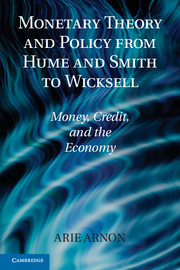Book contents
- Frontmatter
- Dedication
- Contents
- List of Illustrations
- List of Tables
- Preface
- Introduction
- Part one Analytical and Historical Foundations
- Part two Debating Monetary Theory under Inconvertibility
- 5 New Reality
- 6 The Early Round of the Bullion Debate 1800–1802
- 7 Thornton on Inconvertibility and Central Banking
- 8 Ricardo versus Bosanquet
- 9 “Credit Theories of Money” in Exchange and Intermediation
- Part three Debating
- Part four The Road to Defensive Central Banking
- Part five A New Beginning
- Bibliography
- Author Index
- Subject Index
8 - Ricardo versus Bosanquet
The Famous Round of the Bullion Debate
Published online by Cambridge University Press: 05 July 2014
- Frontmatter
- Dedication
- Contents
- List of Illustrations
- List of Tables
- Preface
- Introduction
- Part one Analytical and Historical Foundations
- Part two Debating Monetary Theory under Inconvertibility
- 5 New Reality
- 6 The Early Round of the Bullion Debate 1800–1802
- 7 Thornton on Inconvertibility and Central Banking
- 8 Ricardo versus Bosanquet
- 9 “Credit Theories of Money” in Exchange and Intermediation
- Part three Debating
- Part four The Road to Defensive Central Banking
- Part five A New Beginning
- Bibliography
- Author Index
- Subject Index
Summary
Even during his relatively brief lifetime, David Ricardo (1772–1823) came to provide a special point of reference for his fellow political economists. Since 1776, almost every work of criticism on political economy had taken Adam Smithas its starting point. With the publication of Ricardo’s works, he came to share Smith’s status as a founding father of political economy. Ricardo wrote for only fourteen years, from the age of thirty-seven until his death at the age of fifty-one. He had become very wealthy as a broker in the London Stock Exchange and then devoted his time to studying economic issues of public importance. His first publication, for example, reflected his concern with monetary theory through one of the troubling practical issues of the time: the high price of bullion in 1809, during the Restriction, when the price of gold rose even more than it had in 1800–1801. The implications of the high price of bullion reverberated throughout contemporary society.
Ricardian Monetary Theory: 1809–1811
Ricardo’s contribution to monetary theory began in 1809 with three letters to the Morning Chronicle newspaper. The letters were followed by a pamphlet in 1810 entitled The High Price of Bullion, A Proof of the Depreciation of Bank Notes, known in short as The High Price of Bullion. It is interesting to note that, although the ideas expressed in Ricardo’s celebrated first pamphlet were not original, they won him a name as a distinguished thinker on questions of political economy. From that point until his early death, he analyzed the core, real, and monetary issues in the economy in pamphlets and in the book Principles of Political Economy (1817), and he became a highly acclaimed authority on political economy.
- Type
- Chapter
- Information
- Monetary Theory and Policy from Hume and Smith to WicksellMoney, Credit, and the Economy, pp. 126 - 151Publisher: Cambridge University PressPrint publication year: 2010

